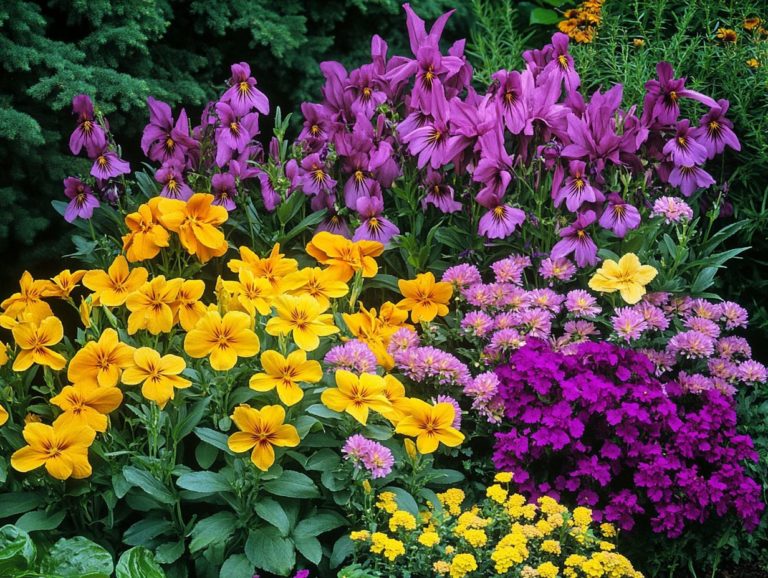Identifying Drought-Resistant Plant Varieties
Drought-resistant plants offer a smart solution for gardening in arid climates. This guide explores their unique characteristics and why you should consider them for your landscape.
Drought tolerance and survival mechanisms make these plants crucial for cultivation. Vital factors to consider when selecting them include climate and soil conditions.
From identifying various drought-resistant types both native and non-native to offering practical care tips, this guide equips you with the knowledge to cultivate a flourishing garden while conserving precious water and resources.
Understanding how plants react to environmental challenges, like drought, is crucial. Embark on this journey to discover the exciting benefits of nurturing plants that not only survive but thrive in tough environments!
Contents
- Key Takeaways:
- Understanding Drought-Resistant Plants
- Why Choose Drought-Resistant Plants?
- Factors to Consider when Choosing Drought-Resistant Plants
- Types of Drought-Resistant Plants
- How to Identify Drought-Resistant Plants
- Caring for Drought-Resistant Plants
- Frequently Asked Questions
- What are drought-resistant plant varieties?
- What are some common characteristics of drought-resistant plants?
- How can I identify drought-resistant plant varieties?
- What are some popular drought-resistant plant varieties?
- Can I grow drought-resistant plant varieties in any climate?
- Are there any benefits to growing drought-resistant plant varieties?
Key Takeaways:

- Drought-resistant plants have unique characteristics that enable them to survive in dry conditions.
- Choosing these plants benefits the environment and saves on water and maintenance costs while enhancing performance in drought scenarios.
- Consider factors like climate and soil when selecting drought-resistant plants, and look for physical and behavioral traits to identify them.
Understanding Drought-Resistant Plants
Understanding drought-resistant plants is essential in today’s agricultural landscape, especially in regions like China, such as Harbin in Heilongjiang, where climate change exacerbates the frequency of droughts. Exploring native plant options for drought-prone regions reveals remarkable plants that have evolved unique traits and mechanisms that allow them to endure extended periods of low moisture, ensuring their survival and productivity even in difficult conditions.
For instance, certain soybean varieties developed through advanced breeding techniques showcase impressive resilience against drought, playing a significant role in food security and sustainable agricultural development.
Employing effective research and evaluation methods is vital for identifying and enhancing these crucial germplasm resources for drought-tolerant varieties.
Definition and Characteristics
Drought-resistant plants possess unique physiological traits that help them thrive in low moisture environments. For those interested in gardening, knowing the most resilient drought-resistant plants is vital for sustainable agriculture amid the challenges of climate change.
These resilient species typically develop deep root systems, allowing them to access groundwater located far below the surface, ensuring a steady supply of moisture during extended dry spells. Their specialized leaf structures often feature thick, waxy coatings or reduced surface areas, which minimize water loss through transpiration.
Some drought-resistant plants even exhibit impressive water retention capabilities, storing moisture in their stems or leaves. This enables them to withstand prolonged periods of drought without significant declines in survival rates. Understanding these remarkable traits is essential for implementing effective agricultural practices that prioritize resilience in an ever-changing climate and its implications for crop production.
Why Choose Drought-Resistant Plants?
Opting for drought-resistant plants presents a wealth of benefits, especially as climate change poses growing threats to crop production and global food security. These plants require significantly less water, making them a smart choice for sustainable agriculture.
By conserving soil moisture and lowering irrigation costs, they align perfectly with eco-friendly practices and improve overall agricultural sustainability. Their remarkable adaptability makes them well-suited for cultivation in water-scarce regions, ultimately bolstering environmental resilience and promoting efficient resource management in agriculture.
Environmental and Cost Benefits
The environmental and cost benefits of drought-resistant plants are impressive, encompassing reduced water usage, lower irrigation expenses, and increased agricultural productivity. This makes them an astute choice for anyone involved in modern farming.
These remarkable plants need less water. This translates into significant savings for farmers and improves survival rates during droughts. They also enhance soil health by promoting deeper root systems, which improves soil structure. This not only helps prevent erosion but also facilitates better nutrient absorption, enhancing plant growth under drought conditions.
By conserving water, these plants play a vital role in preserving local ecosystems and maintaining groundwater levels an increasingly critical factor in regions experiencing prolonged dry spells. Embracing these resilient varieties can lead to greater overall yields and improved performance in the face of climate-induced stress. They provide an essential buffer for food security and economic stability within agricultural communities.
Factors to Consider when Choosing Drought-Resistant Plants

When choosing drought-resistant plants, consider climate conditions, soil characteristics, and drought tolerance traits. Understanding these factors ensures the plants will thrive in challenging conditions while maximizing growth and yield of drought-tolerant varieties.
Experts often stress the significance of evaluating different varieties through thorough analysis, including screening for drought-resistant plants in landscaping, helping you identify the ones best suited for your unique environment.
Climate and Soil Conditions
Knowing your climate and soil conditions is crucial for thriving plants! Understanding these nuances helps you ensure optimal moisture utilization. By carefully assessing these factors, you can pinpoint the ideal plant varieties that are not only resilient to water scarcity but also capable of maximizing growth under challenging conditions, ensuring a better survival rate.
Analyzing the local climate considering rainfall patterns, temperature fluctuations, and the potential effects of drought alongside soil characteristics such as texture and nutrient content offers you valuable insights into moisture retention capabilities. This expertise shapes not only your plant selection but also significantly influences your overall crop yield.
Ultimately, weaving climate and soil analysis into your agricultural planning supports sustainable practices and enhances food security in regions that face the threat of drought and climate change.
Types of Drought-Resistant Plants
Drought-resistant plants can be classified into native and non-native varieties, each presenting distinct advantages for agricultural adaptation across diverse climates, including managing drought conditions effectively.
Native varieties have naturally evolved to endure local drought conditions, offering resilience honed over time, which is critical for food production in affected areas. If you’re looking for these hardy options, you might want to explore where to buy drought-resistant plants locally. On the other hand, non-native varieties, like certain types of soybean, are often meticulously developed through advanced breeding methods to improve drought tolerance and optimize their growth under stress.
By grasping the nuances between these categories, you can make informed decisions in selecting the most appropriate plants for your specific agricultural needs, ultimately enhancing food production and promoting sustainability in the face of abiotic stress.
Start exploring drought-resistant options today and secure a healthier future for your crops!
Native and Non-Native Varieties
Both native and non-native drought-resistant plants are vital for agriculture. Each has unique strengths and weaknesses.
Native varieties excel in local ecosystems, having evolved with the local environment and pests. This evolution boosts their resilience and supports local biodiversity.
These incredible plants thrive on minimal water, making them game-changers for arid regions.
In contrast, non-native varieties can yield more and resist specific diseases. However, they may disrupt local ecosystems by competing with indigenous species. Understanding these dynamics is crucial for maximizing crop production sustainably.
How to Identify Drought-Resistant Plants
Identifying drought-resistant plants requires recognizing specific physical traits. Look for features like deep roots, waxy leaves, and reduced leaf sizes, which are all essential for conserving moisture. Additionally, you can explore emerging trends in drought-resistant plants to enhance your understanding.
Learning their growth patterns will help you select the right varieties for sustainable agriculture, especially the best drought-resistant plants.
Physical and Behavioral Characteristics

Drought-resistant plants have unique adaptations for effective water retention. Their remarkable traits help them thrive in arid conditions.
For instance, they often develop deep root systems that reach groundwater, enabling them to survive dry spells. Their leaves may have reduced surface areas or waxy coatings, minimizing water loss.
In addition to physical traits, many species exhibit behavioral adaptations, such as closing stomata during the hottest parts of the day. This strategy conserves moisture while allowing essential gas exchange.
Caring for Drought-Resistant Plants
Caring for drought-resistant plants requires specific watering and maintenance practices. Consider deep watering methods to promote robust root development and use mulch to minimize evaporation.
By using these strategies, you can boost your crops’ resilience and productivity, even in tough conditions.
Watering and Maintenance Tips
Effective watering techniques and maintenance tips are crucial for drought-resistant plants. These plants thrive in low moisture conditions and support improved crop production.
Use a well-crafted irrigation strategy that minimizes water waste while encouraging deep root growth. It’s vital to establish a watering schedule that allows the soil to dry out between sessions.
Techniques like drip irrigation or soaker hoses deliver water directly to the soil, reducing evaporation. Adding mulch around plants retains soil moisture and suppresses weeds, creating a healthier ecosystem.
Combine these practices to support the growth of drought-resistant varieties while practicing sustainable agriculture.
Frequently Asked Questions
What are drought-resistant plant varieties?
Drought-resistant plant varieties are specially bred or developed to thrive in dry, arid conditions. They are more resistant to drought and water scarcity, making understanding drought resistance in plant species essential, with a focus on variety evaluation.
What are some common characteristics of drought-resistant plants?

Drought-resistant plants often feature deep, extensive root systems. They have thick, waxy leaves that retain moisture and can close their small leaf openings to save water, which are key traits for climate adaptation.
How can I identify drought-resistant plant varieties?
You can identify drought-resistant varieties by noting specific characteristics. Look for plants with low water needs and those tolerant to high temperatures and dry environments. Understanding the benefits of using drought-resistant varieties can also enhance their overall performance in various climates.
What are some popular drought-resistant plant varieties?
Some popular drought-resistant plants include succulents, cacti, lavender, rosemary, and yucca. These plants thrive in dry climates and require minimal watering, making them fantastic choices for drought-tolerant landscaping!
Can I grow drought-resistant plant varieties in any climate?
While many drought-resistant plants can thrive in various climates, it’s crucial to choose varieties suitable for your specific conditions. Consider the role of drought-resistant plants in climate resilience when making your selections.
Are there any benefits to growing drought-resistant plant varieties?
Absolutely! Growing drought-resistant plants comes with amazing benefits. They require less water, making them more environmentally friendly and cost-effective, and they also need less maintenance.
Start your drought-resistant garden today and enjoy the beauty and sustainability these plants bring!






